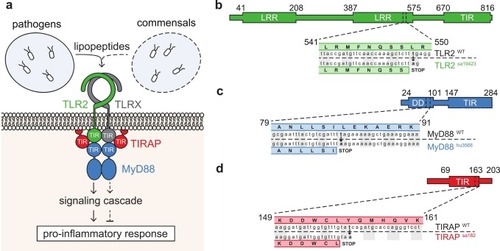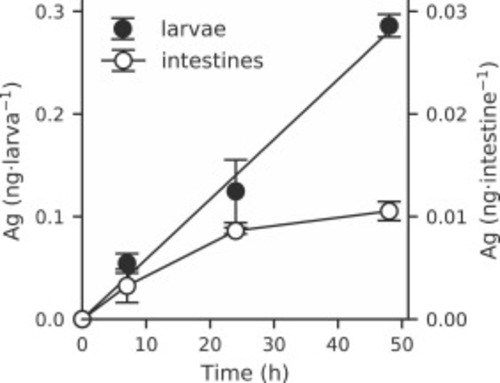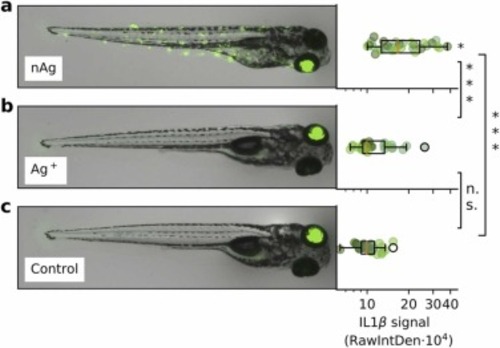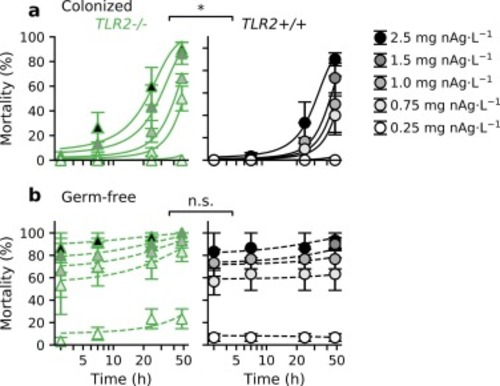- Title
-
Microbiota-dependent TLR2 signaling reduces silver nanoparticle toxicity to zebrafish larvae
- Authors
- Brinkmann, B.W., Koch, B.E.V., Peijnenburg, W.J.G.M., Vijver, M.G.
- Source
- Full text @ Ecotoxicol. Environ. Saf.
|
Fig. 1. Mutant zebrafish lines in the TLR2 signaling pathway. (a) Schematic representation of TLR2 with its adaptor proteins MyD88 and TIRAP (Mal). The Toll/IL-1 receptor (TIR) domain of MyD88 and TIRAP (Mal) can interact with the TIR domain of TLR2. Pathogens have been found to induce pro-inflammatory immune responses via TLR2 (solid line), while commensal microbiota have been shown to dampen pro-inflammatory responses via TLR2 (dashed line). (b-d) Mutant and wildtype alleles with encoded proteins for TLR2 (tlr2sa19423 mutant allele) (b); MyD88 (myd88hu3568 mutant allele) (c); and TIRAP (Mal) (tirapsa182 mutant allele) (d). In all mutant alleles, a threonine to alanine point mutation results in a premature stop codon prior to or inside of the open reading frame for the TIR domain. As a consequence, the mutants produce truncated versions of TLR2, MyD88 or TIRAP, lacking a functional TIR domain. Abbreviations: DD, death domain; LRR, leucine rich repeat; Mal, MyD88 Adaptor-Like; MyD88, Myeloid Differentiation factor 88; TIR, Toll/IL-1 receptor domain; TIRAP, Toll/Interleukin-1 Receptor domain-containing Adaptor Protein; TLR, Toll-Like Receptor. |
|
Fig. 2. Accumulation of total silver in zebrafish larvae. Black circles (left axis) represent silver concentrations in and on the entire larvae, white circles (right axis) represent silver concentrations in the intestines of larvae. |
|
Fig. 3. Particle-specific inflammatory effect of silver nanoparticle exposures. Inflammatory effects were studied using Tg(il1ß:eGFP-F) reporter zebrafish larvae. Pictures show representative images of larvae, with quantification of GFP signal from the anterior side of the swim bladder up to and including the tail fin, following exposure to nAg (0.25 mg nAg·L-1; n = 30) (a), their shed ions (0.05 mg Ag+·L-1; n = 30) (b), and egg water lacking nAg and shed ions (n = 28) (c). Asterisks indicate significant differences: * ** , p < 0.001. Abbreviations: RawIntDent, Raw integrated density; n.s., non-significant. |
|
Fig. 4. TLR2-dependent effects of colonizing microbiota on silver nanoparticle toxicity to zebrafish larvae. Sensitivity of tlr2-/- as compared to tlr2+/+ zebrafish larvae under microbially-colonized conditions (a) and germ-free conditions (b). Asterisks indicate significant differences (n = 3). |
|
Fig. 5. TLR2 adaptor-dependent effects of colonizing microbiota on silver nanoparticle toxicity to zebrafish larvae. (a and c), Sensitivity of myd88-/- as compared to myd88+/+ zebrafish larvae, under microbially-colonized conditions (a) and germ-free conditions (c). (b and d) Sensitivity of tirap-/- as compared to tirap+/+ zebrafish larvae, under microbially-colonized conditions (b) and germ-free conditions (d). Asterisks indicate significant differences (n = 3). |





